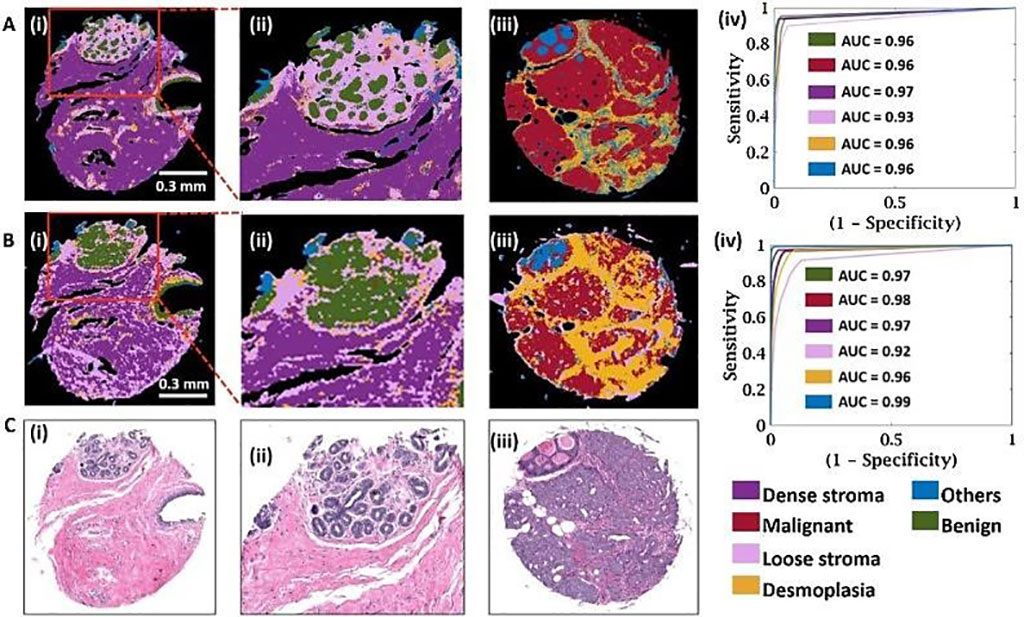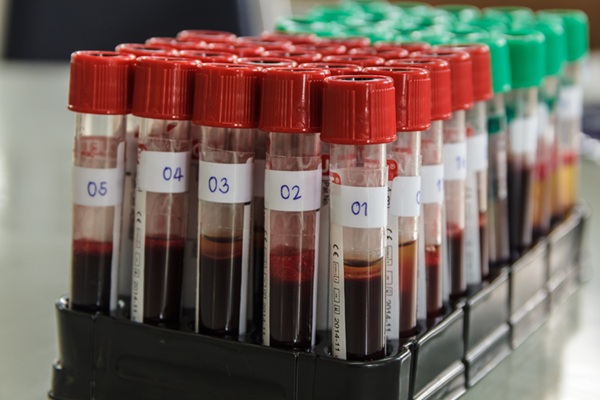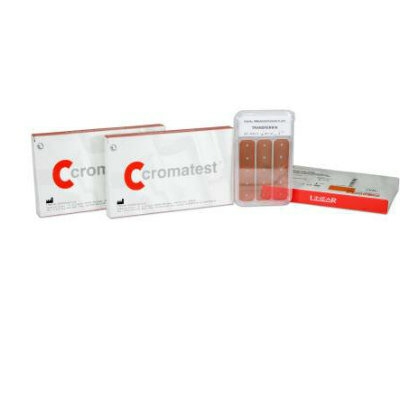Breast Cancer Histopathology Employs Infrared Spectroscopic Imaging
|
By LabMedica International staff writers Posted on 19 Apr 2021 |

Image: Spatial and quantitative comparison of high-definition (HD) and standard definition (SD) classification performance using the 6-class model (Photo courtesy of University of Illinois at Urbana−Champaign)
Digital analysis of cancer specimens using spectroscopic imaging coupled to machine learning is an emerging area that links spatially localized spectral signatures to tissue structure and disease. Breast histopathology, as an example of the broad relevance of these techniques, is critically important for clinical diagnoses.
Current histologic characterization is morphology-based; thin tissue sections are stained, and cells are visually recognized by a pathologist using an optical microscope. However, the basis of the disease is well known to be molecular. Molecular analysis for pathology is complicated by the spatial diversity of cells and acellular materials, necessitating an analytical technique that involves imaging.
Bioengineers at the University of Illinois at Urbana−Champaign (Urbana, IL, USA) and their colleagues examined the role of spatial-spectral tradeoffs in infrared spectroscopic imaging configurations for probing tumors and the associated microenvironment profiles at different levels of model complexity. The imaged breast tissue using standard and high-definition Fourier Transform Infrared (FT-IR) imaging and systematically examine the localization, spectral origins, and utility of data for classification.
The team obtained formalin-fixed, paraffin-embedded serial breast tissue microarrays (TMA) sections. The array consisted of a total of 101 cores of 1 mm diameter from 47 patients. Two sections were stained with hematoxylin and eosin (H&E) and other immunohistochemical markers and imaged with a light microscope. High-definition (HD) FT-IR imaging was conducted using the Agilent Stingray imaging system (Santa Clara, CA, USA) which is comprised of a 680-IR spectrometer coupled to a 620-IR imaging microscope with 0.62 numerical aperture, 25×objective.
The scientists provided a systematic comparison in the use of HD and SD FT-IR imaging data for breast pathology in their study. While the increased spatial localization of spectral signals in HD imaging may have been expected to provide a confounding influence, the study demonstrated that accuracy can be high, and there is significant potential in this sampling mode offering higher sensitivity. The team stated that IR imaging can not only provide the recognition capability of molecular data but can also balance that with an increased quality of morphologic data.
Rohit Bhargava, PhD, bioengineering professor and senior author of the study, said, “As technology expands and provides more capabilities with new features, it becomes more difficult to choose the optimal technology from the many options available. This study provides a nice comparison and guidelines to design a more useful and practical technology.” The study was originally published on February 27, 2021 in the journal Clinical Spectroscopy.
Related Links:
University of Illinois at Urbana−Champaign
Current histologic characterization is morphology-based; thin tissue sections are stained, and cells are visually recognized by a pathologist using an optical microscope. However, the basis of the disease is well known to be molecular. Molecular analysis for pathology is complicated by the spatial diversity of cells and acellular materials, necessitating an analytical technique that involves imaging.
Bioengineers at the University of Illinois at Urbana−Champaign (Urbana, IL, USA) and their colleagues examined the role of spatial-spectral tradeoffs in infrared spectroscopic imaging configurations for probing tumors and the associated microenvironment profiles at different levels of model complexity. The imaged breast tissue using standard and high-definition Fourier Transform Infrared (FT-IR) imaging and systematically examine the localization, spectral origins, and utility of data for classification.
The team obtained formalin-fixed, paraffin-embedded serial breast tissue microarrays (TMA) sections. The array consisted of a total of 101 cores of 1 mm diameter from 47 patients. Two sections were stained with hematoxylin and eosin (H&E) and other immunohistochemical markers and imaged with a light microscope. High-definition (HD) FT-IR imaging was conducted using the Agilent Stingray imaging system (Santa Clara, CA, USA) which is comprised of a 680-IR spectrometer coupled to a 620-IR imaging microscope with 0.62 numerical aperture, 25×objective.
The scientists provided a systematic comparison in the use of HD and SD FT-IR imaging data for breast pathology in their study. While the increased spatial localization of spectral signals in HD imaging may have been expected to provide a confounding influence, the study demonstrated that accuracy can be high, and there is significant potential in this sampling mode offering higher sensitivity. The team stated that IR imaging can not only provide the recognition capability of molecular data but can also balance that with an increased quality of morphologic data.
Rohit Bhargava, PhD, bioengineering professor and senior author of the study, said, “As technology expands and provides more capabilities with new features, it becomes more difficult to choose the optimal technology from the many options available. This study provides a nice comparison and guidelines to design a more useful and practical technology.” The study was originally published on February 27, 2021 in the journal Clinical Spectroscopy.
Related Links:
University of Illinois at Urbana−Champaign
Latest Pathology News
- AI Tool Improves Accuracy of Skin Cancer Detection
- Highly Sensitive Imaging Technique Detects Myelin Damage
- 3D Genome Mapping Tool to Improve Diagnosis and Treatment of Genetic Diseases
- New Molecular Analysis Tool to Improve Disease Diagnosis
- Tears Offer Noninvasive Alternative for Diagnosing Neurodegenerative Diseases
- AI-Powered Method Combines Blood Data to Accurately Measure Biological Age
- AI Tool Detects Cancer in Blood Samples In 10 Minutes
- AI Pathology Analysis System Delivers Comprehensive Cancer Diagnosis
- AI Improves Cervical Cancer Screening in Low-Resource Settings
- New Multi-Omics Tool Illuminates Cancer Progression
- New Technique Detects Genetic Mutations in Brain Tumors During Surgery within 25 Minutes
- New Imaging Tech to Improve Diagnosis and Treatment of Skin Cancers
- Serially Testing Brain Tumor Samples Reveals Treatment Response in Glioblastoma Patients
- High-Accuracy Tumor Detection Method Offers Real-Time Surgical Guidance
- AI Tool Detects Hidden Warning Signs of Disease Inside Single Cells
- Automated Tool Detects Early Warning Signs of Breast Cancer
Channels
Clinical Chemistry
view channel
VOCs Show Promise for Early Multi-Cancer Detection
Early cancer detection is critical to improving survival rates, but most current screening methods focus on individual cancer types and often involve invasive procedures. This makes it difficult to identify... Read more
Portable Raman Spectroscopy Offers Cost-Effective Kidney Disease Diagnosis at POC
Kidney disease is typically diagnosed through blood or urine tests, often when patients present with symptoms such as blood in urine, shortness of breath, or weight loss. While these tests are common,... Read moreMolecular Diagnostics
view channel
New Biomarker Panel to Improve Heart Failure Diagnosis in Women
Heart failure affects millions worldwide, yet many women are still misdiagnosed or diagnosed too late. Although heart failure broadly means the heart cannot pump enough blood to the body’s cells, its two... Read more
Dual Blood Biomarkers Improve ALS Diagnostic Accuracy
Diagnosing amyotrophic lateral sclerosis (ALS) remains difficult even with advanced imaging and genetic tools, especially when clinicians must distinguish it from other neurodegenerative conditions that... Read moreHematology
view channel
ADLM’s New Coagulation Testing Guidance to Improve Care for Patients on Blood Thinners
Direct oral anticoagulants (DOACs) are one of the most common types of blood thinners. Patients take them to prevent a host of complications that could arise from blood clotting, including stroke, deep... Read more
Viscoelastic Testing Could Improve Treatment of Maternal Hemorrhage
Postpartum hemorrhage, severe bleeding after childbirth, remains one of the leading causes of maternal mortality worldwide, yet many of these deaths are preventable. Standard care can be hindered by delays... Read more
Pioneering Model Measures Radiation Exposure in Blood for Precise Cancer Treatments
Scientists have long focused on protecting organs near tumors during radiotherapy, but blood — a vital, circulating tissue — has largely been excluded from dose calculations. Each blood cell passing through... Read moreImmunology
view channel
Chip Captures Cancer Cells from Blood to Help Select Right Breast Cancer Treatment
Ductal carcinoma in situ (DCIS) accounts for about a quarter of all breast cancer cases and generally carries a good prognosis. This non-invasive form of the disease may or may not become life-threatening.... Read more
Blood-Based Liquid Biopsy Model Analyzes Immunotherapy Effectiveness
Immunotherapy has revolutionized cancer care by harnessing the immune system to fight tumors, yet predicting who will benefit remains a major challenge. Many patients undergo costly and taxing treatment... Read moreMicrobiology
view channel
15-Minute Blood Test Diagnoses Life-Threatening Infections in Children
Distinguishing minor childhood illnesses from potentially life-threatening infections such as sepsis or meningitis remains a major challenge in emergency care. Traditional tests can take hours, leaving... Read more
High-Throughput Enteric Panels Detect Multiple GI Bacterial Infections from Single Stool Swab Sample
Gastrointestinal (GI) infections are among the most common causes of illness worldwide, leading to over 1.7 million deaths annually and placing a heavy burden on healthcare systems. Conventional diagnostic... Read moreTechnology
view channel
AI Model Achieves Breakthrough Accuracy in Ovarian Cancer Detection
Early diagnosis of ovarian cancer remains one of the toughest challenges in women’s health. Traditional tools such as the Risk of Ovarian Malignancy Algorithm (ROMA) can struggle to distinguish between... Read more
Portable Biosensor Diagnoses Psychiatric Disorders Using Saliva Samples
Early diagnosis of psychiatric disorders such as depression, schizophrenia, and bipolar disorder remains one of medicine’s most pressing challenges. Current diagnostic methods rely heavily on clinical... Read more
Cell-Sorting Device Uses Electromagnetic Levitation to Precisely Direct Cell Movement
Sorting different cell types—such as cancerous versus healthy or live versus dead cells—is a critical task in biology and medicine. However, conventional methods often require labeling, chemical exposure,... Read moreIndustry
view channel
Co-Diagnostics Forms New Business Unit to Develop AI-Powered Diagnostics
Co-Diagnostics, Inc. (Salt Lake City, UT, USA) has formed a new artificial intelligence (AI) business unit to integrate the company's existing and planned AI applications into its Co-Dx Primer Ai platform.... Read more






















